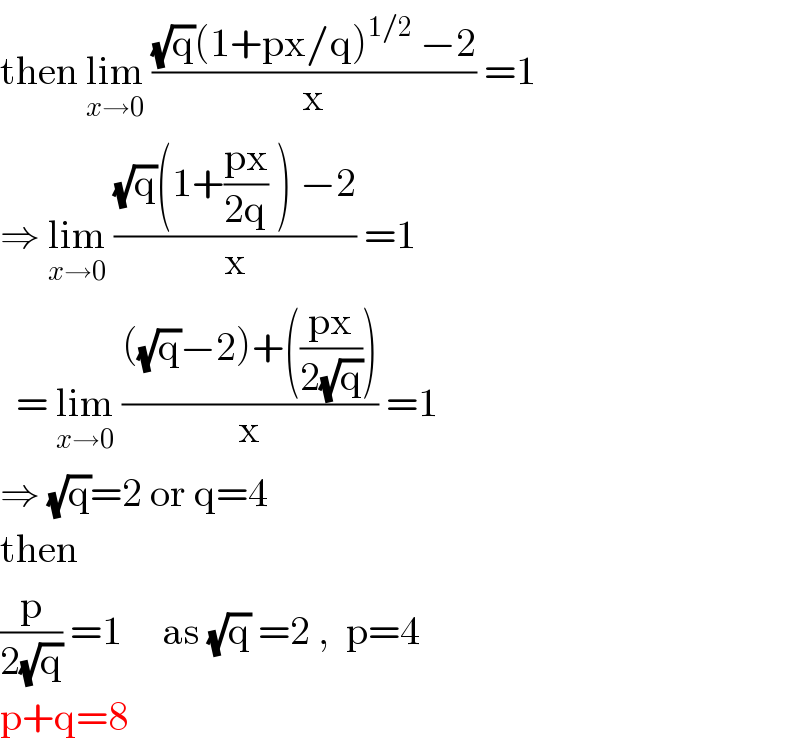
Question Number 11444 by Joel576 last updated on 26/Mar/17

$$\mathrm{If}\:\:\underset{{x}\rightarrow\mathrm{0}} {\mathrm{lim}}\:\frac{\sqrt{{px}\:+\:{q}}\:−\:\mathrm{2}}{{x}}\:=\:\mathrm{1} \\ $$$$\mathrm{What}\:\mathrm{is}\:\mathrm{the}\:\mathrm{value}\:\mathrm{of}\:\:{p}\:+\:{q}\:? \\ $$
Answered by ajfour last updated on 26/Mar/17

$$\mathrm{then}\:\underset{{x}\rightarrow\mathrm{0}} {\mathrm{lim}}\:\frac{\sqrt{\mathrm{q}}\left(\mathrm{1}+\mathrm{px}/\mathrm{q}\right)^{\mathrm{1}/\mathrm{2}} \:−\mathrm{2}}{\mathrm{x}}\:=\mathrm{1} \\ $$$$\Rightarrow\:\underset{{x}\rightarrow\mathrm{0}} {\mathrm{lim}}\:\frac{\sqrt{\mathrm{q}}\left(\mathrm{1}+\frac{\mathrm{px}}{\mathrm{2q}}\:\right)\:−\mathrm{2}}{\mathrm{x}}\:=\mathrm{1} \\ $$$$\:\:=\:\underset{{x}\rightarrow\mathrm{0}} {\mathrm{lim}}\:\frac{\left(\sqrt{\mathrm{q}}−\mathrm{2}\right)+\left(\frac{\mathrm{px}}{\mathrm{2}\sqrt{\mathrm{q}}}\right)}{\mathrm{x}}\:=\mathrm{1} \\ $$$$\Rightarrow\:\sqrt{\mathrm{q}}=\mathrm{2}\:\mathrm{or}\:\mathrm{q}=\mathrm{4} \\ $$$$\mathrm{then} \\ $$$$\frac{\mathrm{p}}{\mathrm{2}\sqrt{\mathrm{q}}}\:=\mathrm{1}\:\:\:\:\:\mathrm{as}\:\sqrt{\mathrm{q}}\:=\mathrm{2}\:,\:\:\mathrm{p}=\mathrm{4} \\ $$$$\mathrm{p}+\mathrm{q}=\mathrm{8} \\ $$
Commented by Joel576 last updated on 26/Mar/17

$${thank}\:{you}\:{very}\:{much} \\ $$
Answered by ridwan balatif last updated on 26/Mar/17

$$\underset{{x}\rightarrow\mathrm{0}} {\mathrm{lim}}\frac{\sqrt{\mathrm{px}+\mathrm{q}}−\mathrm{2}}{\mathrm{x}}=\mathrm{1} \\ $$$$\mathrm{test}\:\mathrm{limit}:\:\frac{\sqrt{\mathrm{p}×\mathrm{0}+\mathrm{q}}−\mathrm{2}}{\mathrm{0}}=\mathrm{1}\rightarrow\mathrm{this}\:\mathrm{is}\:\mathrm{Impossible} \\ $$$$\mathrm{so}\:\mathrm{form}\:\mathrm{of}\:\mathrm{the}\:\mathrm{test}\:\mathrm{limit}\:\mathrm{should}\:\mathrm{be}\:\frac{\mathrm{0}}{\mathrm{0}} \\ $$$$\sqrt{\mathrm{p}×\mathrm{0}+\mathrm{q}}−\mathrm{2}=\mathrm{0} \\ $$$$\sqrt{\mathrm{q}}−\mathrm{2}=\mathrm{0} \\ $$$$\mathrm{q}=\mathrm{4} \\ $$$$\underset{{x}\rightarrow\mathrm{0}} {\mathrm{lim}}\frac{\sqrt{\mathrm{px}+\mathrm{4}}−\mathrm{2}}{\mathrm{x}}=\mathrm{1} \\ $$$$\underset{{x}\rightarrow\mathrm{0}} {\mathrm{lim}}\left(\frac{\left(\sqrt{\mathrm{px}+\mathrm{4}}−\mathrm{2}\right)}{\mathrm{x}}×\left(\frac{\sqrt{\mathrm{px}+\mathrm{4}}+\mathrm{2}}{\sqrt{\mathrm{px}+\mathrm{4}}+\mathrm{2}}\right)\right)=\mathrm{1} \\ $$$$\underset{{x}\rightarrow\mathrm{0}} {\mathrm{lim}}\left(\frac{\mathrm{px}+\mathrm{4}−\mathrm{4}}{\mathrm{x}\left(\sqrt{\mathrm{px}+\mathrm{4}}+\mathrm{2}\right.}\right)=\mathrm{1} \\ $$$$\underset{{x}\rightarrow\mathrm{0}} {\mathrm{lim}}\frac{\mathrm{px}}{\mathrm{x}\left(\sqrt{\mathrm{px}+\mathrm{4}}+\mathrm{2}\right)}=\mathrm{1} \\ $$$$\underset{{x}\rightarrow\mathrm{0}} {\mathrm{lim}}\frac{\mathrm{p}}{\sqrt{\mathrm{px}+\mathrm{4}}+\mathrm{2}}=\mathrm{1} \\ $$$$\frac{\mathrm{p}}{\sqrt{\mathrm{p}×\mathrm{0}+\mathrm{4}}+\mathrm{2}}=\mathrm{1} \\ $$$$\frac{\mathrm{p}}{\mathrm{2}+\mathrm{2}}=\mathrm{1} \\ $$$$\mathrm{p}=\mathrm{4} \\ $$$$\mathrm{q}=\mathrm{4} \\ $$$$\therefore\mathrm{p}+\mathrm{q}=\mathrm{8} \\ $$
